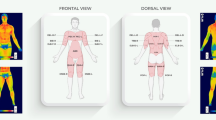Abstract
Exercise has a noted effect on skin blood flow and temperature. We aimed to characterize the normal skin temperature response to exercise by thermographic imaging. A study was conducted on ten healthy and active subjects (age=25.8 ± 0.7 years) who were exposed to graded exercise for determination of maximal oxygen consumption (VO2 max), and subsequently to constant loads corresponding to 50%, 70%, and 90% of VO2 max. The skin temperature response during 20 min of constant load exercise is characterized by an initial descending limb, an ascending limb and a quasi-steady-state period. For 50% VO2 the temperature decrease rate was --0.0075±0.001°C/s during a time interval of 390 ±47 s and the temperature increase rate was 0.0055 ± 0.0031 °C/s during a time interval of 484 ±99 s. The level of load did not influence the temperature decrease and increase rates. In contrast, during graded load exercise, a continuous temperature decrease of --0.0049 ± 0.0032 °C/s was observed throughout the test. In summary, the thermographic skin response to exercise is characterized by a specific pattern which reflects the dynamic balance between hemodynamic and thermoregulatory processes. © 1998 Biomedical Engineering Society.
PAC98: 8722Pg, 8759Wc, 8745Dr, 0180+b, 8745Hw
Similar content being viewed by others
REFERENCES
Abramson, D. P. I. Circulation in the Extremities. London: Academic, 1967.
Brengelmann, G. L., J. M. Johnson, L. Hermansen, and L. B. Rowell. Altered control of skin blood flow during exercise at high internal temperatures. J. Appl. Physiol.43(5):790-794, 1977.
Chabanski, S. Spectral Analysis and Filtration of Dynamic Infra-red Images of the Human Body. Technion, Israel: MSc Research Thesis, 1993.
Christensen, E., M. Nielsen, and B. Hannisdahl. Investigations of the circulation in the skin at the beginning of muscular work. Acta Physiol. Scand.4:162, 1942.
Clark, R., M. Goff, and J. Culley. High resolution thermography in medicine. J. Photogr. Sci.37:168-171, 1989.
Johnson, J. M. Exercise and the cutaneous circulation. Exercise Sport Sci. Rev.20:59-97, 1992.
Kenney, W. L., and J. M. Johnson. Control of skin blood flow during exercise. Med. Sci. Sports Exercise24(3):303- 312, 1992.
Kirsis, F. Issledovanie kozhnogo krovotoka v nerabotaushchey konechnosti pri fizicheskoi nagruzke. Teor. Prakt. Fiz. Kul't.8:29-31, 1975.
Lowenthal, M., K. Harpuder, and S. Blatt. Peripheral and visceral vascular effects of exercise and postprandial state in supine position. J. Appl. Physiol.4:689, 1952.
Muth, H., P. Wormald, J. Bishop, and K. Donald. Further studies of blood flow in the resting arm during supine leg exercise. Clin. Sci.17:603, 1958.
Robinson, S. Temperature regulation in exercise. Pediatrics (Suppl.)32:691, 1963.
Rowell, L. B. Blood pressure regulation during exercise. Ann. Med. (Helsinki)23:329-33, 1991.
Vander, A. Human Physiology. New York: McGraw-Hill, 1990, pp. 415, 596.
Author information
Authors and Affiliations
Rights and permissions
About this article
Cite this article
Zontak, A., Sideman, S., Verbitsky, O. et al. Dynamic Thermography: Analysis of Hand Temperature During Exercise. Annals of Biomedical Engineering 26, 988–993 (1998). https://doi.org/10.1114/1.33
Issue Date:
DOI: https://doi.org/10.1114/1.33




